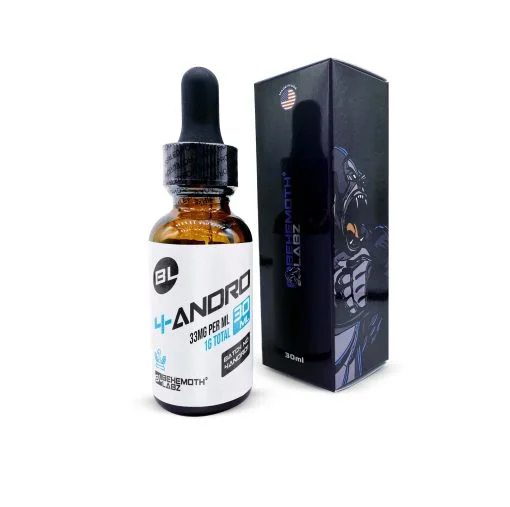SARMs
SR9009 Stenabolic: Possible Research Applications, Side Effects, and More
SR9009, commonly known as Stenabolic, is a synthetic research compound that has garnered attention for its impact on cellular metabolism and circadian regulation in preclinical studies. As an agonist of the Rev-ErbA nuclear receptor, SR9009 is being explored for its role in modulating various physiological pathways in non-human models.
All existing data on SR9009 stems from preclinical investigations, and it is strictly intended for research purposes. The compound is not approved for human consumption or therapeutic use.
What is SR9009?
SR9009 is a synthetic research compound often recognized for its potential performance-related effects in preclinical studies. Though commonly associated with SARMs due to overlapping investigative purposes, SR9009 is technically a Rev-ErbA (circadian nuclear receptor) agonist, not a SARM.
Rev-ErbA is a protein expressed in various tissues, including the liver, the central nervous system, adipose tissue, and skeletal muscle. In laboratory models, SR9009 has been observed to activate this receptor, potentially supporting metabolic regulation and cardiovascular efficiency under specific research conditions.
Since SR9009 is non-hormonal, some studies suggest it may not interfere with endocrine activity in test environments. However, all findings are limited to non-human or controlled laboratory settings, and the compound is not approved for human consumption.
How Does SR9009 Work?
SR9009 is a synthetic compound studied for its role as a Rev-ErbA agonist, which influences the activity of this protein in various tissues.
In controlled lab environments, SR9009 has shown potential to increase mitochondrial density in skeletal muscle tissue, which may correlate with enhanced endurance-like outcomes in non-human models.
Additionally, activation of the Rev-ErbA receptor in hepatic and adipose regions supports lipid processing and mobilization. Laboratory data indicate that SR9009 might affect genes linked to lipid accumulation, which could translate to reduced fat deposition under specific investigational scenarios.
These findings are based on preclinical data, and SR9009 is intended strictly for research purposes only.
Research Applications of SR9009
The following are research-based applications of SR9009 in preclinical models. These findings are strictly derived from controlled laboratory studies and should not be interpreted as indications for therapeutic or human use.
1. Investigating Cellular Energy Utilization and Mitochondrial Biogenesis
SR9009 has been studied for its potential to influence mitochondrial density and efficiency in skeletal muscle tissues. By activating Rev-ErbA receptors, it may enhance mitochondrial biogenesis and oxidative capacity, facilitating studies on cellular endurance, bioenergetic efficiency, and muscle-specific energy metabolism. These findings support its use in research examining mitochondrial function in metabolic tissues.
2. Modulating Fat Loss Biomarkers
Experimental evidence from rodent models indicates that SR9009 may modulate lipid metabolism by influencing genes responsible for fatty acid synthesis, storage, and mobilization. In preclinical settings, alterations in hepatic lipid profiles and adipose tissue markers have been observed. Researchers use SR9009 to better understand the molecular basis of lipid homeostasis and metabolic flexibility.
3. Influencing Muscle Mass Pathways
While SR9009 does not directly induce hypertrophic responses, it may modulate metabolic pathways that are integral to skeletal muscle energy balance and fatigue resistance. In laboratory models, its administration has been associated with enhanced expression of metabolic genes and improved markers of mitochondrial function, which are of interest in studies on muscle physiology and metabolic adaptation.
4. Studying Cardiac Bioenergetics and Remodeling Mechanisms
The Rev-ErbA receptor plays a critical role in cardiac energy metabolism and circadian regulation. In research involving pressure overload and myocardial infarction models, SR9009 has been used to examine its potential effects on cardiac remodeling, mitochondrial efficiency, and tissue repair mechanisms. These studies contribute to a deeper understanding of cardiac energetics and stress adaptation.
5. Impacting Indicators of the Inflammation System
SR9009 has shown the ability to influence inflammatory markers in preclinical models. Specifically, reductions in cytokine levels such as CCL2 and MMP-9 have been noted in studies involving pulmonary and systemic inflammation. These findings suggest a potential role for SR9009 in elucidating the molecular pathways underlying inflammation and immune response regulation.
Research Uses of SR9009
SR9009 is broadly used in preclinical studies. As a bioactive compound, Stenabolic is utilized to investigate the following effects in research investigations:
- Regulation of lipid metabolism and fatty acid oxidation
- Examination of mitochondrial biogenesis and function
- Investigation of glucose metabolism in metabolic disease models
- Analysis of cardiac function and circadian regulation
- Studies of energy expenditure and systemic metabolic balance
- Exploration of inflammatory and immune response markers
All uses of SR9009 are confined to research laboratories and involve non-human experimental models.
SR9009 (Stenabolic) Results
As a Rev-ErbA agonist, SR9009 has demonstrated a 50% improvement in performance metrics in murine experimental models.
Furthermore, research studies have reported approximately 3-8% reduction in adipose tissue mass in research subjects over an 8-week experimental period. Based on these findings, Stenabolic is frequently utilized to achieve optimal and effective outcomes in laboratory trials.
SR9009 Stacking with SARMs
In certain preclinical studies, SR9009 has been co-administered with selective androgen receptor modulators (SARMs) to evaluate synergistic effects on metabolic and musculoskeletal endpoints. Compounds such as Ostarine (MK-2866) and LGD-4033 have been explored in combination with SR9009 to study their combined influence on tissue-specific metabolic markers.
These investigations are purely exploratory and remain within the context of non-human laboratory models.
Conclusion
SR9009 (Stenabolic) remains a compound of significant scientific interest due to its ability to modulate Rev-ErbA activity and influence metabolic, cardiac, and inflammatory pathways in preclinical settings. Its unique pharmacological profile supports diverse applications in basic and applied biomedical research.
Importantly, SR9009 is not approved for human use and is designated for research purposes only. Investigators should ensure the use of high-purity material and appropriate protocols to maximize data reliability and reproducibility.
FAQs
What is the best place to buy SR9009 online?
SR9009 is available from various suppliers that specialize in research-use-only compounds. It is essential to verify product purity, certification, and supplier reputation to ensure reliable outcomes in preclinical studies. Always purchase SR9009 from sources that comply with research-use standards.
Is Stenabolic SR9009 legal?
SR9009 is legal for use in laboratory and preclinical research settings. It is not authorized for therapeutic use or human consumption.
What is the effect of SR9009?
SR9009 functions as an agonist of the Rev-ErbA nuclear receptor, influencing gene expression involved in circadian rhythm, metabolic regulation, and mitochondrial activity in experimental models.
What is the half-life of Stenabolic SR9009?
In preclinical pharmacokinetic studies, SR9009 has demonstrated a half-life of approximately 4–6 hours.
Does SR9009 increase mitochondria?
Yes. SR9009 has been associated with increased mitochondrial biogenesis in skeletal muscle tissue in preclinical studies.
References
- Dierickx, Pieterjan, et al. “SR9009 has REV-ERB–independent effects on cell proliferation and metabolism.” Proceedings of the National Academy of Sciences 116.25 (2019): 12147-12152.
- Li, Hui, et al. “SR9009 improves heart function after pressure overload independent of cardiac REV-ERB.” Frontiers in Cardiovascular Medicine 9 (2022): 952114.
- Reitz, Cristine J., et al. “SR9009 administered for one day after myocardial ischemia-reperfusion prevents heart failure in mice by targeting the cardiac inflammasome.” Communications Biology 2.1 (2019): 353.










